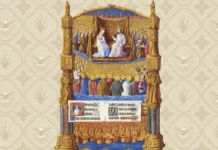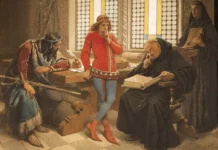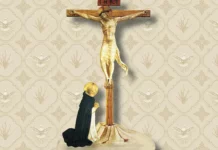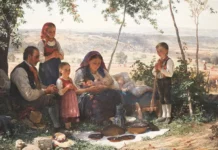This was the moment that all mankind was somehow awaiting: when God would take care of us, when the world would be saved and God would renew all things.
“The time came for Mary to be delivered. And She gave birth to her first-born Son and wrapped Him in swaddling clothes, and laid Him in a manger, because there was no room for them in the inn” (Lk 2:6f.). These words touch our hearts every time we hear them. This was the moment that the Angel had foretold at Nazareth: “You will bear a Son, and you shall call his name Jesus. He will be great, and will be called the Son of the Most High” (Lk 1:31). This was the moment that Israel had been awaiting for centuries, through many dark hours – the moment that all mankind was somehow awaiting, in terms as yet ill-defined: when God would take care of us, when He would step outside His concealment, when the world would be saved and God would renew all things.
We can imagine the kind of interior preparation, the kind of love with which Mary approached that hour. The brief phrase: “She wrapped Him in swaddling clothes” allows us to glimpse something of the holy joy and the silent zeal of that preparation. The swaddling clothes were ready, so that the Child could be given a fitting welcome. Yet there is no room at the inn. In some way, mankind is awaiting God, waiting for Him to draw near. But when the moment comes, there is no room for Him. […]
“To all who received Him…”
St. John, in his Gospel, went to the heart of the matter, giving added depth to St. Luke’s brief account of the situation in Bethlehem: “He came to His own home, and His own people received Him not” (Jn 1:11). This refers first and foremost to Bethlehem: the Son of David comes to His own city, but has to be born in a stable, because there is no room for Him at the inn. Then it refers to Israel: the One who is sent comes among His own, but they do not want Him. And truly, it refers to all mankind: He through whom the world was made, the primordial Creator-Word, enters into the world, but He is not listened to, He is not received. […]
Thank God, this negative detail is not the only one, nor the last one that we find in the Gospel. Just as in Luke we encounter the maternal love of Mary and the fidelity of St. Joseph, the vigilance of the shepherds and their great joy, just as in Matthew we encounter the visit of the wise men, come from afar, so too John says to us: “To all who received Him, He gave power to become children of God” (Jn 1:12). There are those who receive Him, and thus, beginning with the stable, with the outside, there grows silently the new house, the new city, the new world. […]
His new throne is the Cross
In some Christmas scenes from the late Middle Ages and the early modern period, the stable is depicted as a crumbling palace. It is still possible to recognize its former splendour, but now it has become a ruin, the walls are falling down – in fact, it has become a stable. Although it lacks any historical basis, this metaphorical interpretation nevertheless expresses something of the truth that is hidden in the mystery of Christmas.
David’s throne, which had been promised to last for ever, stands empty. Others rule over the Holy Land. […] In the stable of Bethlehem, the very town where it had all begun, the Davidic kingship started again in a new way – in that Child wrapped in swaddling clothes and laid in a manger. The new throne from which this David will draw the world to Himself is the Cross. […] Yet this is exactly how the true Davidic palace, the true kingship is being built. […] The power that comes from the Cross, the power of self-giving goodness – this is the true kingship.
Feast of restored creation
The stable becomes a palace – and setting out from this starting-point, Jesus builds the great new community, whose key-word the Angels sing at the hour of His birth: “Glory to God in the highest, and peace on earth to those whom He loves” – those who place their will in His, in this way becoming men of God, new men, a new world. […]
What Christ rebuilds is no ordinary palace. He came to restore beauty and dignity to creation, to the universe: this is what began at Christmas and makes the Angels rejoice. The Earth is restored to good order by virtue of the fact that it is opened up to God, it obtains its true light anew, and in the harmony between human will and divine will, in the unification of height and depth, it regains its beauty and dignity. Thus Christmas is a feast of restored creation. […]
Heaven comes down to Earth
In the stable at Bethlehem, Heaven and Earth meet. Heaven has come down to Earth. For this reason, a light shines from the stable for all times; for this reason joy is enkindled there; for this reason song is born there.
At the end of our Christmas meditation I should like to quote a remarkable passage from St. Augustine. Interpreting the invocation in the Lord’s Prayer: “Our Father who art in Heaven”, he asks: what is this – Heaven? And where is Heaven? Then comes a surprising response: “… who art in Heaven – that means: in the Saints and in the just. Yes, the heavens are the highest bodies in the universe, but they are still bodies, which cannot exist except in a given location. Yet if we believe that God is located in the heavens, meaning in the highest parts of the world, then the birds would be more fortunate than we, since they would live closer to God. Yet it is not written: ‘The Lord is close to those who dwell on the heights or on the mountains’, but rather: ‘the Lord is close to the broken-hearted’ (Ps 34:18[33:19]), an expression which refers to humility. Just as the sinner is called ‘Earth’, so by contrast the just man can be called ‘Heaven’” (Sermo in monte II 5, 17).
Heaven does not belong to the geography of space, but to the geography of the heart. And the heart of God, during the Holy Night, stooped down to the stable: the humility of God is Heaven. And if we approach this humility, then we touch Heaven. Then the earth too is made new. With the humility of the shepherds, let us set out, during this Holy Night, towards the Child in the stable! Let us touch God’s humility, God’s heart! Then His joy will touch us and will make the world more radiant. Amen. ◊
Excerpts from: BENEDICT XVI.
Homily of the Solemnity of the
Nativity of the Lord, 25/12/2007
In the featured photo: Adoration of the Magi, by Gentile da Fabriano – Uffizi Gallery, Florence (Italy)







